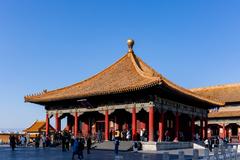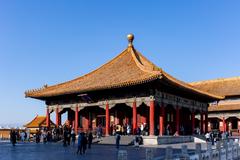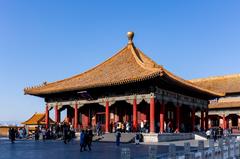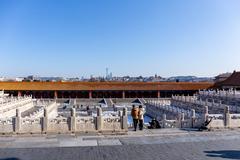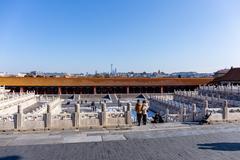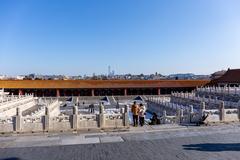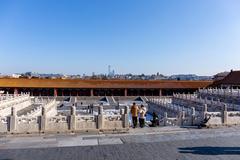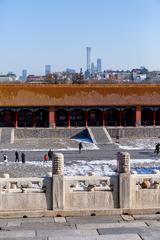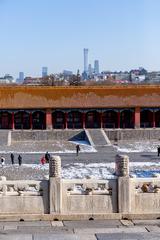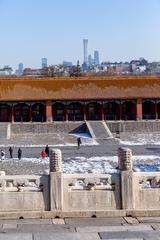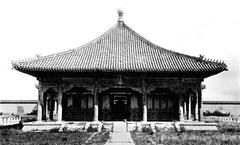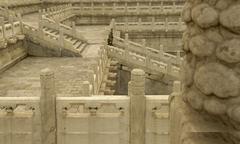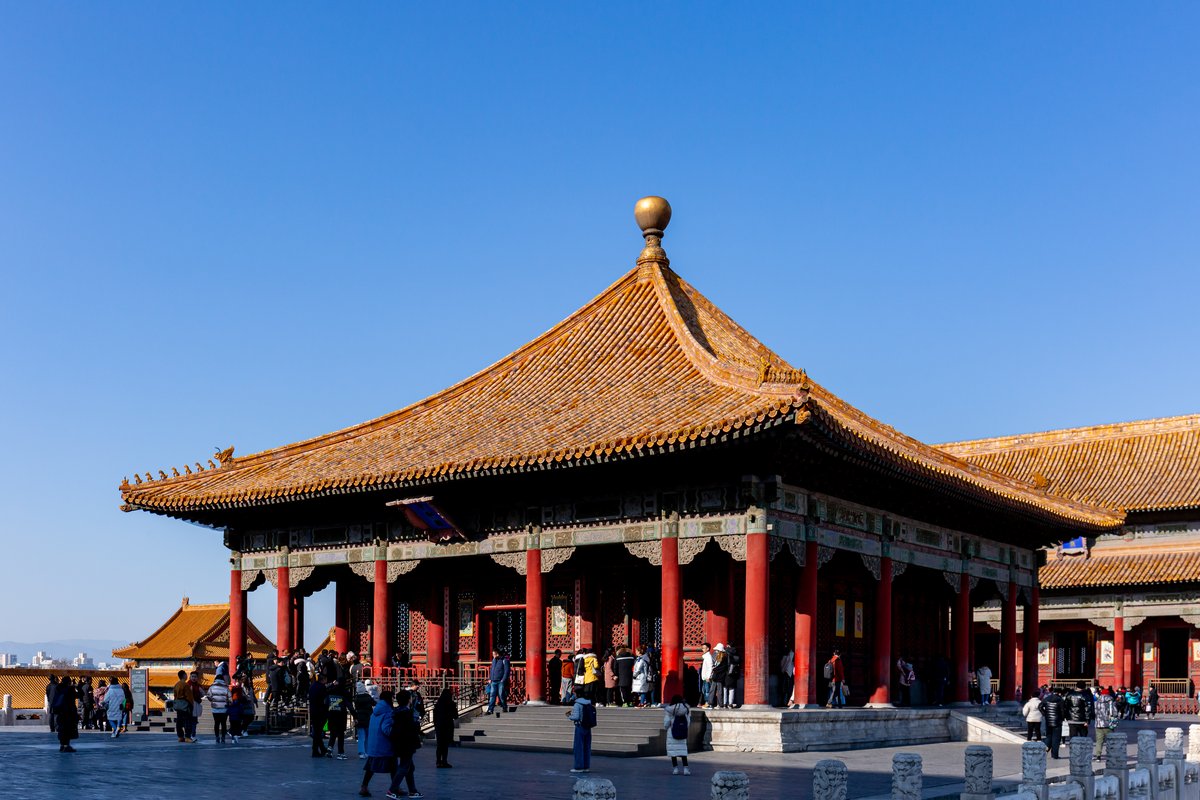
Visiting the Hall of Central Harmony, Beijing: Tickets, Hours, and Expert Tips
Date: 14/06/2025
Introduction
The Hall of Central Harmony (中和殿, Zhonghedian) is an iconic structure at the heart of Beijing’s Forbidden City, serving as an architectural and philosophical bridge between the Hall of Supreme Harmony and the Hall of Preserving Harmony. Constructed in 1420 during the Ming Dynasty, this hall symbolizes the Confucian doctrine of “central harmony”—a principle of balanced moderation that shaped imperial governance and cosmology. Modest in size but rich in meaning, the Hall of Central Harmony was the emperor’s space for ritual preparation before grand ceremonies, embodying both imperial authority and the pursuit of cosmic balance (ChinaTour360; designhorizons.org; chinatripedia.com).
Today, the hall remains a key destination for those exploring Beijing’s historical sites, offering insight into China’s dynastic heritage. This guide provides an in-depth look at the hall’s history, architecture, symbolism, and practical information—such as visiting hours, ticketing, accessibility, and touring tips—to ensure an enriching visit (Red Travel Book; China Highlights).
Table of Contents
- Origins and Historical Evolution
- Ceremonial Functions and Dynastic Roles
- Symbolism and Philosophy
- Architectural Features
- Preservation and Legacy
- Practical Visitor Information
- Frequently Asked Questions (FAQ)
- Conclusion and Final Recommendations
- References
Origins and Historical Evolution
The Hall of Central Harmony was established in 1420 under the Yongle Emperor of the Ming Dynasty. Initially called ‘Huagaidian,’ it was rebuilt after a fire and renamed ‘Zhonghedian’ during the Qing Dynasty, inspired by the Confucian Doctrine of the Mean (中庸). The hall’s central location and modest size reflect its role as a transitional, contemplative space for emperors before public ceremonies (ChinaTour360; Red Travel Book).
Ceremonial Functions and Dynastic Roles
Ming Dynasty (1368–1644)
The hall functioned as an antechamber where emperors composed themselves, reviewed ritual documents, and received briefings before significant state ceremonies in the Hall of Supreme Harmony. This reinforced the importance of order, preparation, and cosmic balance in imperial rule (Red Travel Book).
Qing Dynasty (1644–1911)
Qing emperors continued these traditions, using the hall for ritual preparation before enthronements, imperial weddings, and state celebrations. It also served as a venue for private consultations and finalization of ceremonial arrangements, reinforcing the emperor’s mediating role between heaven, earth, and his subjects (ChinaTour360).
Symbolism and Philosophy
The hall’s name and central axis placement manifest Confucian ideals of moderation and harmony. Its modest scale, compared to the neighboring halls, signifies that genuine authority is rooted in restraint and balance. The imperial throne at its center represents the emperor’s cosmic mandate and political role (designhorizons.org; Red Travel Book).
The architectural design also aligns with traditional cosmological concepts—the square plan symbolizes earth, circular motifs represent heaven, and the balance between these elements illustrates the emperor’s responsibility to maintain universal equilibrium (chineselearning.com).
Architectural Features
Layout and Structure
Strategically located along the Forbidden City’s north-south axis, the Hall of Central Harmony sits between the Hall of Supreme Harmony and the Hall of Preserving Harmony. The hall’s square plan (about 36 meters wide by 22 meters deep) and modest size highlight its transitional and contemplative function (chinatripedia.com; chinatour.net).
Timber Framework and Dougong Brackets
Built using traditional timber-frame techniques, the hall features impressive wooden columns and beams, with intricate dougong (bracket) systems that distribute the weight of the roof and add decorative splendor. No nails are used, ensuring both flexibility and seismic resistance (architecturelab.net).
Roof and Decoration
The single-eave hip roof is adorned with imperial yellow glazed tiles, reserved for the emperor, and crowned with a gilded finial symbolizing heaven. The number of roof ridges and decorative figures indicate the building’s rank. Inside, caisson ceilings and painted motifs of dragons and clouds reinforce the emperor’s divine mandate (historyskills.com; travelchinaguide.com).
Foundation and Platform
The hall stands atop a three-tiered white marble terrace with ornate balustrades and staircases. Carved dragon-head spouts form an elegant drainage system, combining utility with symbolic grandeur (chinatripedia.com).
Interior Features
The central imperial throne is flanked by ritual objects such as incense burners, gilded vessels, and sedan chairs. Windows on all sides provide ventilation and light, in accordance with feng shui principles (chinatour.net).
Preservation and Legacy
With the establishment of the Palace Museum in 1925, the Hall of Central Harmony became a treasured public heritage site. Restoration efforts continue to utilize traditional materials and techniques, preserving the hall’s authenticity and historical integrity (ChinaTour360; chinatripedia.com).
Practical Visitor Information
Visiting Hours
- April–October: 8:30 AM – 5:00 PM (last entry 4:00 PM)
- November–March: 8:30 AM – 4:30 PM (last entry 3:30 PM)
- Closed on Mondays (except national holidays).
- Always verify with the Palace Museum official website for current hours.
Tickets
- General admission: 60 RMB (peak season), 40 RMB (off-peak)
- Tickets include all main halls; special exhibitions may require an extra fee.
- Purchase online in advance due to daily visitor limits (Asia Odyssey Travel).
Accessibility
- Wheelchair access is provided along the central axis, with ramps and elevators available for major halls.
- Some areas have steps and uneven surfaces; advance inquiry is advised for visitors with mobility needs.
Travel Tips
- Visit early or late in the day to avoid crowds.
- Allocate 2–3 hours for the central axis and main halls.
- Wear comfortable shoes; surfaces can be slippery.
- Use guided tours or audio guides to enrich your experience (ruqintravel.com).
Nearby Attractions
- Hall of Supreme Harmony
- Hall of Preserving Harmony
- Imperial Garden
- Tiananmen Square (within walking distance)
- Jingshan Park for panoramic city views
Guided Tours and Events
- Guided tours (in-person and virtual) are widely available, providing historical context and architectural insight.
- Seasonal exhibitions and cultural events are occasionally held—check official updates.
Photography Guidelines
- Photography is generally permitted outside; interior photography may be restricted to protect artifacts.
- No flash or tripods allowed; respect barriers and other visitors.
Frequently Asked Questions (FAQ)
Q: What are the Hall of Central Harmony’s visiting hours?
A: 8:30 AM–5:00 PM (April–October), 8:30 AM–4:30 PM (November–March), with last entry one hour before closing.
Q: How much are tickets?
A: 60 RMB (peak season), 40 RMB (off-peak); purchase online in advance.
Q: Is the hall wheelchair accessible?
A: Yes, with ramps and accessible routes along the central axis; some areas require assistance.
Q: Can visitors enter the hall?
A: Interior entry is not permitted; the hall may be viewed from open doorways.
Q: Are guided tours available?
A: Yes, in multiple languages via tour operators and the Palace Museum app.
Q: Is photography allowed?
A: Exterior photography is permitted; interior photography is usually restricted.
Conclusion and Final Recommendations
The Hall of Central Harmony remains a profound testament to imperial China’s pursuit of moderation, harmony, and ritual order. Its architectural elegance, deep-rooted symbolism, and ceremonial significance enrich any journey through the Forbidden City. For a rewarding visit, plan ahead: purchase tickets online, arrive early, and consider a guided tour. Explore adjacent halls and nearby attractions to fully appreciate the historical and cultural landscape of Beijing.
For up-to-date information, consult the Palace Museum website, and leverage trusted resources like Asia Odyssey Travel and China Highlights. For enhanced touring, download the Audiala app and follow our channels for expert insights and updates.
Visual and Interactive Resources
- Virtual tour: Forbidden City Virtual Tour including Hall of Central Harmony
- High-resolution images with descriptive alt text (e.g., “Hall of Central Harmony Forbidden City Beijing”).
- Interactive maps highlighting the hall’s location within the Forbidden City.
References
- ChinaTour360: Hall of Central Harmony
- designhorizons.org: Exploring The Forbidden City’s Architectural Wonders
- chinatripedia.com: Hall of Central Harmony
- Asia Odyssey Travel: How to Visit Forbidden City
- China Highlights: Forbidden City Visiting Tips
- chineselearning.com: The Forbidden City and the Five Elements
- Red Travel Book: Forbidden City Guide
- chinatour.net: Central Harmony Hall
- architecturelab.net: Forbidden City Architecture
- historyskills.com: The Forbidden City
- travelchinaguide.com: Hall of Central Harmony
- tour-beijing.com: Visiting Forbidden City
- ruqintravel.com: Forbidden City Sightseeing
- Hit the Road Ket: Forbidden City Visit Guide
